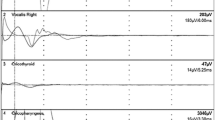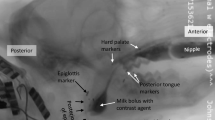Summary
-
1.
The effect, on the subglottic pressure and on the emitted orientation sounds, of selectively cutting nerves to various laryngeal muscles of the Big Brown Bat,Eptesicus fuscus, was studied.
-
2.
Bilateral inferior laryngeal neurotomy caused no change in the repetition rate, duration, initial frequency or bandwidth of downward sweeping frequency modulated (FM) pulses, but after this treatment mean subglottic pressure at pulse onset was lowered 8 to 16 cm H2O and the mean peak pulse intensity was reduced 4 to 5 dB. The relationship of subglottic pressure to the bandwidth of the FM sweep was also altered (Table 1, Figs. 1, 2, 3).
-
3.
Inferior laryngeal neurotomy also caused the bat to produce atypical rising FM pulses which began at about 20 kHz and swept upward almost one octave (Table 1, Fig. 2).
-
4.
Total bilateral superior laryngeal neurotomy eliminated most of the FM and reduced the fundamental frequency to 7.9 kHz with multiple harmonics (Fig. 4). Pulse duration became highly variable and the peak sound pressure level (SPL) dropped 7 to 13 dB (Table 2). The correlation between subglottic pressure and pulse SPL was also eliminated.
-
5.
Bilateral section of only the caudal branch of the superior laryngeal nerve reduced the fundamental frequency of the pulses to 10 kHz and eliminated most of the frequency modulation. Pulse SPL was reduced about 10 dB, but pulse onset subglottic pressure remained correlated with the maximum SPL (Table 2).
-
6.
Paralysis of the tongue by bilateral section of the hypoglossal nerves distal to the thyrohyoid twigs had no detectable effect on the downward sweeping FM pulses, but caused the bats to also emit long duration pulses whose frequency rose and fell in a sinusoidal fashion (Figs. 5, 6).
-
7.
The muscular control of pulse frequency and intensity is discussed in the light of these data. The aberrant rising FM after section of the inferior laryngeal nerves and sigmoid pulses after hypoglossal neurotomy can be understood as the result of timing errors in the opening and/or closing of the glottis relative to the contraction-relaxation cycle of the cricothyroid muscles.
Similar content being viewed by others
Abbreviations
- FM :
-
frequency modulation
- ILN :
-
inferior laryngeal nerve
- SLN :
-
superior laryngeal nerve
References
Blevins C (1970) Morphologic correlates of tympano-laryngeal function in echolocating bats. Anat Rec 166:404
Blevins C, Tillman B (1967) Innervation patterns in intrinsic laryngeal muscles of the bat. Anat Rec 157:215
Bowden R. Scheuer J (1961) Comparative studies of the nerve supply of the larynx of eutherian mammals. Proc Zool Soc (Lond) 136:325–330
Fattu JM, Suthers RA (1981) Subglottic pressure and the control of phonation by the ehcolocating bat,Eptesicus. J Comp Physiol 143:465–475
Feild J, Holbrook J (1969) Neural structures in intrinsic tongue musculature of the bat. Anat Rec 163:184–185
Griffin DR (1958) Listening in the dark. Yale University Press, New Haven
Griffiths TA (1976) The comparative anatomy of the hyoid, laryngeal, and jaw musculature and of the hyoid apparatus of eight genera of phyllostomid and two genera of mormoopid bats. MS thesis. University of Vermont
Henson O (1970) The central nervous system. In: Wimsatt W (ed) Biology of bats II. Academic Press, New York, pp 58–152
Jürgens U, Hast M, Pratt R (1978) Effects of laryngeal nerve transection on squirrel monkey calls. J Comp Physiol 123:23–29
Kallen F, Kaplan Z, Webber R (1968) Parameters of gross anatomy and peripheral innervation affecting phonation in the batMyotis lucifugus. Anat Rec 160:372–373
Koyama T, Harvey J, Ogura J (1971) Mechanics of voice production. II. Regulation of pitch. Laryngoscope 81:47–65
Michel VC (1961) Différenciation dans les cordes vocales des chauve-souris en rapport avec l'émission d'ultrasons. CR Soc Biol (Paris) 155:1143–1145
Motta MG (1951/1952) Experienze per l'individuazione dell'organo produttore degli ultrasuoni nei Pipistrelli mediante lo studio del volo cieco. Boll Soc Ital Biol Sper 27:859–862, 862–868, 1164–1169; 28:207–209
Novick A, Griffin D (1961) Laryngeal mechanisms in bats for the production of orientation sounds. J Exp Zool 148:125–145
Pye JD (1967) Synthesizing the waveforms of bat pulses. In: Busnel R-G (ed) Animal sonar systems. I. Laboratoire Physiologie Acoustique, Jouy-en-Josas, pp 43–64
Quay W (1970) Peripheral nervous system. In: Wimsatt W (ed) Biology of bats. II. Academic Press, New York, pp 153–180
Rubin H (1963) Experimental studies on vocal pitch and intensity in phonation. Laryngoscope 73:973–1015
Rübsamen R (1980) Activity of the recurrent laryngeal nerve due to the production of ultrasonic echolocation sounds in the CF-FM bat,Rhinolophus ferrumequinum. In: Busnel R-G, Fish JF (ed) Animal sonar systems. Plenum Press, New York, pp 969–971
Schuller G, Suga N (1976) Laryngeal mechanisms for the emission of CF-FM sounds in the Doppler shift compensating bat,Rhinolophus ferrumequinum. J Comp Physiol 107:253–262
Shipp T, McGlone R (1971) Laryngeal dynamics associated with voice frequency change. J Speech Hear Res 14:761–769
Sprague J (1943) The hyoid region of placental mammals with special reference to the bats. Am J Anat 72:385–472
Suga N, Schlegel P (1972) Neural attenuation of responses to emitted sounds in echolocating bats. Science 177:82–84
Suthers RA, Fattu JM (1973) Mechanisms of sound production by echolocating bats. Am Zool 13:1215–1226
Author information
Authors and Affiliations
Rights and permissions
About this article
Cite this article
Suthers, R.A., Fattu, J.M. Selective laryngeal neurotomy and the control of phonation by the echolocating bat,Eptesicus . J. Comp. Physiol. 145, 529–537 (1982). https://doi.org/10.1007/BF00612818
Accepted:
Issue Date:
DOI: https://doi.org/10.1007/BF00612818




